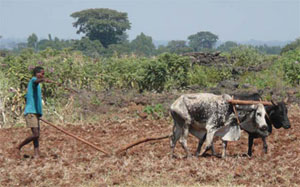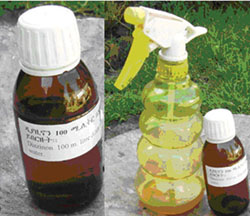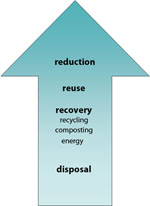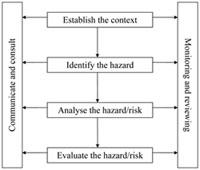ENVIRONMENTAL LITERACY
ENVIRONMENTAL LITERACY
What is an environmental hazard?
Our environment generally consists of physical, chemical and biological factors and our relationship with our environment is always interactive. This means that we affect our environment and our environment affects us. These interactions may expose us to environmental health hazards; that is any environmental factors or situations that can cause injury, disease or death.
Difference between hazard and risk
Hazard: is something which is known to cause harm, that is, a source of danger to health.
Risk is the likelihood or probability of the hazard occurring and the magnitude of the resulting effects. For example, if you climb a ladder you know there is a chance you could fall off and be injured, although it is unlikely. The ladder is the hazard and the chance of injury is the risk you take by climbing the ladder.
We will illustrate an environmental health hazard with an example. The production of cow dung cake to be used for fuel is a common practice in Ethiopia. Fresh dung supports the breeding of flies. Dung cake is usually prepared near to the house (Figure 2.1). Young flies need food and move from the dung to the food that is found in the house.

The conditions or the situation of producing dung cake close to the house is hazardous (or dangerous) because it facilitates the breeding of flies near to fresh food in the house. The infected food is the hazard that damages the child’s health. In this example, the hazard arises because of the infectious agent (the pathogenic organisms) and the process or condition (the preparation of cow dung cake close to the house). The risk of getting an infection is very high if someone consumes food that is contaminated with an infectious agent.
QUESTION: What causes environmental hazards? List some different types of natural and human-produced hazards.
Categories of environmental health hazards
Hazards are generally categorized as follows:
- Physical hazards
- Biological hazards
- Chemical hazards
- Cultural/practice-related hazards
- Social hazards
Physical hazards
Physical hazards are those substances or conditions that threaten our physical safety. Fires, explosive materials, temperature (hot or cold), noise, radiation, spills on floors and unguarded machines are some examples of physical hazards.
Physical hazards also include ergonomic hazards which occur when the type of work, body position and working conditions put strain on your body. This happens when your capacity for work is restricted by the type of work. These instances are hard to spot since you don’t always immediately notice the strain on your body or the harm these hazards cause. Short-term exposure in badly designed work may result in muscle fatigue or tiredness, but long-term exposure can result in serious long-term injuries of the musculo-skeletal system.

Biological hazards
Biological hazards are organisms, or by-products from an organism, that are harmful or potentially harmful to human beings.
They include pathogenic bacteria, viruses and parasites, and also toxins (poisons) that are produced by organisms.
Biological hazards are the cause of the majority of human diseases. For example, bacteria cause cholera, tuberculosis, leprosy, relapsing fever and many diarrheic diseases; viruses are responsible for hepatitis B and C, HIV, measles and polio; and there are many diseases caused by parasites.
A parasite is any organism that lives on or in another organism, called the host, and causes damage, ill health or even death to the host.
Some human parasites are external and live on the skin and hair, for example, mites that cause scabies. Internal parasites, living inside the body, include protozoa and helminths.
Protozoan parasites are single-celled organisms that enter the body either by ingestion or via the bite of an infected insect. Malaria, sleeping sickness and leishmaniasis are examples of diseases caused by protozoan parasites introduced by insect bites; amoebic dysentery and giardiasis result from drinking or eating contaminated water or food.
Helminths are parasitic worms that live inside the body. Several helminths have complicated life cycles involving humans and other animals as secondary hosts. They have different routes of entry into the human body depending on the type of worm including ingestion with food or water, the faeco-oral route, insect bites and penetration through the skin. ‘Helminth’ is the general term used to describe several different types of parasitic worm. There are three main groups: tapeworms, roundworms and flukes. Tapeworms may be ingested with food, especially under-cooked meat, or with water or soil contaminated with faeces. Roundworms, also called nematodes, are responsible for many different diseases including ascariasis, dracunculiasis (guinea worm), filariasis, hookworm, onchocerciasis (river blindness), trichinosis and trichuriasis (whipworm). A type of fluke is the cause of schistosomiasis, also known as bilharzia. People become infected with schistosomiasis, not through food, but by standing or swimming in water that contains the immature form of the fluke; these are released into the water from the snail secondary host. The fluke gets into the water and the snail from the excreta of infected people.
Biological hazards arise from working with infected people or animals, or handling infectious waste and body fluids, as well as contact with unsafe water, food and waste. The hazards may occur in the home, at school or at work. In particular, work in hospitals, hotel and hospital laundries, laboratories, veterinary offices and nursing homes may expose someone to biological hazards.
Chemical hazards
Chemical hazards are present when a person is exposed to a harmful chemical at home or at work.
The chemicals can be in the form of gases, solids or liquids. Exposure to chemicals could cause acute health effects (an immediate or rapid onset) if taken in large quantities in a single dose; and chronic health effects (long-term effects on health) if taken in small doses over an extended time.
Detergents (powdered soap, bleaching powder), drugs (veterinary and human) and pesticides (DDT, malathion, diazinon, zinc phosphide, warfarin) are chemical hazards that are commonly found in rural households (Figure 2.3).
Farmers, young children (under 5 years) and household animals are vulnerable to chemical exposure, but it is always possible that anyone might come into contact with the chemical during preparation, spraying, use or storage.
A person is exposed to chemicals through various ways: through inhaling the vapors, gases or dusts; through skin contact with solvents, acids and alkalis; and through ingestion of unknown chemicals with food and water.

Incomplete burning of fuel releases carbon monoxide (CO) which is a chemical hazard. When breathed in, CO binds to the hemoglobin in our blood, reducing the uptake of oxygen; the cells of the body then suffer because they are not getting enough oxygen. This can result in severe sickness and even death.
Cultural/practice-related hazards
Culture is the knowledge, belief, art, law, morals, customs and habits that are acquired by people as members of society. It is also the common ways of life and set of thoughts and feelings shared by the members of a society. Just as there are cultural practices that are good for health, such as breastfeeding a child, there are also cultural practices that adversely affect health and these can be considered to be cultural hazards. There are practices that are widely accepted and found in different areas of Ethiopia that can be hazards for health; for example, the belief that evil spirits are the source of diseases, practices of storing drinking water uncovered, open defecation and not handwashing before meals and after latrine use.
QUESTION: Let us assume you have observed that one of the households in your area has a clean latrine but it has not been used for the last few months. What could be the explanation for not using the latrine?
Describing environmental exposure to hazards
To reduce the adverse impacts of environmental hazards on human health you need to understand where the hazard comes from, identify it and the pathway it can take to affect people.
The source of the hazard is the place of origin from proposed and existing activities.
Industrial processes in a factory release chemical hazards that may be found in sewage; the sewage could reach drinking water, thereby creating the possibility of ingesting these chemicals.
Household activities could also be sources of hazards, for example, cooking with fuels such as animal dung and charcoal produces toxic smoke that can cause lung diseases.
The type of hazard is the particular chemical, infectious agent or other agent involved. The pathway is the route by which the hazard gets from the source to the person.
If you want to prevent a hazard, you need to understand the source of the hazard (where it comes from), the type of hazard (for example the type and concentration of a chemical), the pathway (the affected environment and how the exposure could take place), and the response (the effect the hazard could have on people).
------------------Practice--------------------
We will demonstrate this with an example. Sewage containing cadmium (a toxic chemical) is produced by a hide-processing factory and flows into a river. People downstream of the point of discharge drink the contaminated water and become sick. The hazard exposure is described as follows:
- The source is sewage from a factory.
- The type of hazard is chemical, in this case cadmium.
- The pathway or affected environment is the river that is used by the public as a source of drinking water and the exposure took place by swallowing/ ingesting the chemical with drinking water. In addition, any fish contaminated with cadmium may have been eaten.
- The response is that people who consumed the contaminated water and fish had symptoms of cadmium poisoning (i.e. joint and spinal pains, pains in the abdomen) and they complained to a health centre.
Principles of hazard management
You may be asked to plan how to manage environmental hazards, say in a Health Post or mill house that exists in your locality. Involvement in hazard management requires you to follow certain steps, which are outlined below.
- Establish the context and identify the hazard: These are the first steps. You have learned that a hazard is something that is harmful to our health. A description of the categories of hazards is given in Section 2.2 above. You should identify the type of the hazard in as much detail as you can. You should also describe the exposure conditions and try to answer the following questions: What is the source of the hazard? Who is exposed? What are the pathways or activities that expose a person? What part of the environment is involved in the transfer of the hazard to humans?
- Hazard/risk analysis and evaluation: Here you would analyse the risk and evaluate the potential of the hazard to cause damage to health. This step needs a deeper appraisal in collaboration with the woreda environmental health worker. The evaluation may require appropriate design, sampling and laboratory investigation.
- Communicate and consult: When the hazards and risks have been determined, advice can be communicated on the interventions or control measures that are needed to control the hazard. There can also be consultations with relevant people and organisations.
- Treat the hazard/risk: The interventions or control measures are carried out by the person or people responsible for the hazard or risk.
- Monitoring and reviewing: The implementation of interventions or control measures for the hazard must be followed up in order to determine whether they are successful. Correction measures can be applied if there is any failure. Identifying appropriate indicators for monitoring is critical and must be done formally.
- Record keeping: Keeping records and reports on hazard management is always important. These records must contain the type of hazard, exposures and what control measures were taken.
The process of hazard management is shown in Figure 2.4.
Environmental pollution
2.5.1 What is pollution?
We have seen that hazards are things that endanger human health or life, but hazards can also be harmful to our environment. Pollution is the introduction of contaminants into an environment causing harm, instability or disorder to the ecosystem. (An ecosystem includes all the living organisms (plants, animals, microorganisms) and their physical environment and the interactions between them.) Pollution can be also defined as the presence of a substance in a medium or environment that results in a change to its ‘natural’ state, potentially causing an adverse effect. Pollution, however, is not simply the introduction of contaminants. There is always a response in the form of modification or change in the environment. From this standpoint, pollution is the harm that results because substances are present where they would not normally be found, or because they are present in larger than normal quantities.
Contaminants are not necessarily pollutants. A contaminant is a minor substance, material or agent that is unwanted in the environment and may or may not be harmful. A pollutant is a contaminant which, due to its properties or amount or concentration, causes harm. Gases (carbon monoxide, ozone, nitrogen dioxides), chemical vapours, dust particles, fumes and liquid chemicals (pesticides, solvents, drugs, acids, etc.) are examples of potential pollutants of air and water ecosystems.
In nature, the environment has an inherent capacity to clean itself through self-cleaning processes. Natural environmental processes have the ability to deal with many pollutants and correct most imbalances if given enough time. For example, self-cleaning processes in a river could involve:
Key terminologies
- Dilution: this takes place when a small amount of a chemical in sewage enters a large flowing river and the pollutant is diluted in the water.
- Oxygenation: this process occurs through mixing of air with water which introduces oxygen that can then be used by aquatic (water-living) plants and animals. Microorganisms consume oxygen when they break down organic matter.
- Sedimentation: this takes place when larger particles settle out at the bottom of the river.
- Biodegradation: this takes place when organic matter is broken down by microorganisms. Organic matter means everything that is derived from living organisms. In a river this could be human and animal waste, decaying plant material, etc.
Pollution sources and categories
Pollutants can come from natural or man-made sources. Examples of natural sources of pollution are volcanoes which give out ash and dust into the atmosphere and metals such as arsenic which are naturally present in some rocks and soils. Man-made pollutants can come from industrial, domestic (home), transport and agricultural sources.
Think of one example of a pollutant from industrial, domestic (home), transport and agricultural sources.
Pollution can take many forms. The air we breathe, the water we drink, the soil where we grow our food, and even the increasing noise we hear every day all contribute to health problems and a lower quality of life. Pollution can be classified as:
- Air pollution: the release of chemicals and particulates into the atmosphere.
- Water pollution: the release of wastes, chemicals and other contaminants into surface and groundwater.
- Soil pollution: the release of wastes, chemicals and other contaminants into soil.
- Radioactive pollution: presence of radioactive substances in the environment.
- Noise pollution: unacceptable levels of noise in work, residential and recreational places.
- Thermal pollution: the release of heat into the environment; for example heated water into a river.
Air pollution
This occurs with the release of chemicals in gaseous or dust form into the atmosphere. Household cooking, industries, vehicles and incinerators are common sources of air pollution.
Water pollution
Water can be polluted by the release of liquid waste (human, animal or industrial) into rivers, streams and lakes. A common type of water pollution is organic material such as human and animal wastes and in waste water from food processing. These wastes can be removed from rivers and lakes by the self-cleaning processes described above but, if present in large quantities, the biodegradation process can reduce the level of dissolved oxygen in the water so much that fish and other aquatic life cannot survive. As well as these environmental impacts, water contaminated with human waste is a significant cause of many diseases that will be described in more detail elsewhere in this Module. Some pollutants can be extremely harmful even if they are taken in small quantities and may cause cancer, reproductive health effects (abortion, embryo malformation, birth defects) or nerve damage when the contaminated water is consumed.
Land/soil pollution
This occurs when land is used as a site for accumulating wastes that are generated from various sources (industry, agriculture, health facilities, villages, private and public organisations). These wastes may be biologically, chemically or physically hazardous to plants and animals. The pollution by chemicals such as pesticides may have long-term consequences, such as groundwater pollution.
Principles of pollution management
Explain the differences between a hazard, a contaminant and a pollutant.
There are two main approaches to pollution management:
- Pollution prevention: focuses on stopping pollution being produced in the first place, or reducing any waste generation at the source.
- Pollution control: those measures taken to control pollution and wastes after they have been generated or produced.
Principles of pollution prevention
There are a number of principles of pollution prevention; we will briefly discuss some of them.
Principle of waste optimisation: The motto in this principle is ‘Do not produce any waste; if this is not possible, reduce or minimise waste generation as much as possible’.

There are three ‘Rs’ that are applied in waste optimization: Reduce, Reuse and Recover. Figure above shows the hierarchy or the order in which the waste optimization options should be used.
Reduction refers to changing the process so that waste is not produced in the first place.
Reuse involves using an item more than once (for example you can reuse plastic bottles for collecting water).
Recovery involves recovery of materials or energy through recycling, composting and incineration. An example of recycling is taking used aluminum cans (tin cans) and recycle the metal to make it into something else. In composting we can take waste organic matter and make it into useful compost for fertilizer. Through incineration (burning) we can recover the energy contained in waste materials. There is more information on these processes in Study Session 22 on solid waste management.
The concept of waste optimization is applied in industries through cleaner production. Cleaner production implies appropriate environmental management, waste minimization, replacement of toxic chemicals, process and product modification, and the application of the three ‘Rs’.
----------Principles---------------
Polluter pays principle: This principle identifies the people or organizations who generate or produce waste or pollution as those who are accountable for any human or ecological damage. They are responsible for paying the costs of any damage. The principle is an economic tool to enforce accountability and responsibility. Strict standards for pollutant discharge permissions and enforcing heavy taxation on products or waste handling are ways of making the polluter pay.
Principle of ‘Cradle to Grave’: This principle applies to the production of any object or to any activity by an individual or institution and all the pollution that object or activity might cause throughout its lifecycle; that is, from its ‘cradle’ to its ‘grave’. For example, if you make a plastic bottle, pollution might be caused in the manufacturing process; pollution is also caused by the lorries that transport the bottles around the country; and pollution is caused when the bottle is thrown away. All these aspects should be taken into account.
Precautionary principle: For any activity, there is an obligation not to cause harm even when someone is uncertain about the effect of the activity on humans and the environment. Under this principle, you take precautions to avoid environmental damage, even if you are not certain that damage will result. The application of waste minimisation is an example.
Principle of duty of care: Any person or organisation that produces waste, i.e. a waste generator, has a citizenship and ethical obligation to handle their waste properly. They have a duty to ensure that it does not harm other people or the environment.
Principle of discharge/emission permit: A waste generator has an obligation to obtain permission from the regulatory authority in order to discharge waste to surface water and to the atmosphere.
Principle of sustainable development:
What do you remember about the term ‘sustainable development’?
Sustainable development requires people to carry out environmental mitigation (lessening the damaging effects) for newly developed factories, dams, irrigation schemes and other undertakings as prescribed by law.
Principle of the right to know: The public has the right to information about pollution from a particular process. Public participation at various stages of project development avoids mistrust and the consequences of conflicts of interest.
Pollution control
Pollution prevention through various applicable principles and methods is not always possible and the consequence is that some pollution is produced. If pollution is produced, there should be some measures to control it and minimise the effects on people and the environment. The application of waste treatment before disposal, restricting contact between the waste and the public, and monitoring and evaluating the effect of the waste on the immediate environment are some of the intervention options in waste control. Pollution control options will be explored later in this Module.
------------------------Summary-------------------------
You have learned that:
- An environmental health hazard is anything in the environment that endangers human health and life; there are various types of environmental health hazard.
- Managing environmental health hazards requires knowledge of environmental health hazard identification, exposure conditions including the pathways of the hazards and hazard controls or interventions.
- The principle of hazard management involves hazard recognition, deeper analysis of the risk of the hazard and the control or treatment and monitoring of the hazard.
- Contamination and pollution are different; uncertainty of damage is a characteristic of contamination, while there is certainty of harm in the case of pollution.
- The environment has a natural self-cleaning process. Pollution occurs when the self-cleaning process is defeated. The consequence of water, air and soil pollution is damage to the environment and to humans.
- Pollution management is an extension of hazard management with the focus on pollution prevention and control. Pollution prevention and control principles address various concepts including accountability, responsibility, and economic and environmental liability.
Assessment Question
Now that you have completed this study session, you can assess how well you have achieved its Learning Outcomes by answering these questions. Write your answers in your Study Diary and discuss them with your Tutor at the next Study Support Meeting. You can check your answers with the Notes on the Self-Assessment Questions at the end of this Module.
Question 1
Match the descriptions with the following key terms: hazard and pollution, contamination. Explain the reasons for your answer.
Later a new industry releases its liquid waste into the same river. The mill house also continued to release its waste. Fishes in the river began to die. Fishing became difficult. The community downstream did not like the taste of the water.
Contamination
Pollution
Hazard
A mill house is releasing its liquid waste into a nearby river. The community drinks the water below the discharge point. There was no complaint when people drank the water. There were no observations of fish dying. The amount of the chemical was not significant.
The amount of the chemical was not known. No one knows if the chemical in the waste is harmful or not.
Drag each answer (above) into the correct slot (below).
Question 2
Have a walk-through visit at the Health Post in your locality and think about any environmental hazards you might find there. List the types and sources of possible hazards and their health effects.
Question 3
Describe the key steps in hazard management planning. Using your answer to Q 2, what are the appropriate interventions for the hazards you have identified?
Question 4
Think about the possible types of pollution that could be produced from a health centre.
- a.List the types of pollution that could be produced, giving one example of each type.
- b.Describe the two main approaches to pollution management. Outline the pollution management methods that could be used for the pollutants you have listed.
- DOWNLOAD THE STUDY MATERIALS BELOW
 |
| Environmental education |
 |
| Sustainable resource Use |
| Major environmental concerns |
 |
| World's major environmental concerns |
| environmental protocols and conventions |
 |
| detailed environmental protocols |
 |
| PPT environmental protocols |
| PPT environmental conventions 2 |
Videos on the effect of global warming






Comments
Post a Comment
Have a question? Feel Free to ask DTAL for any assistance.